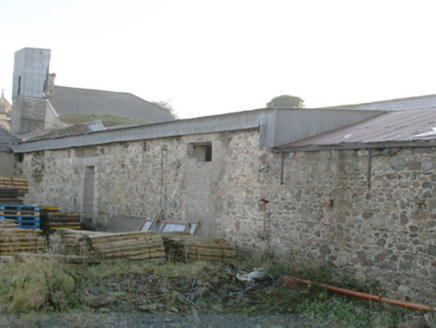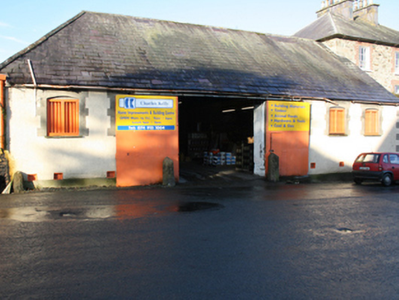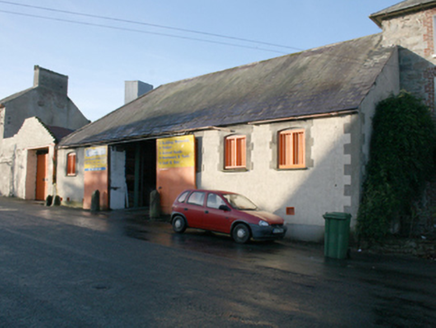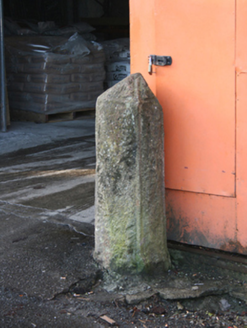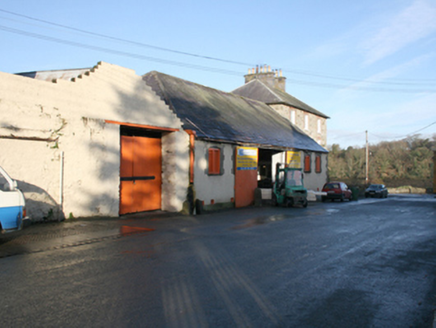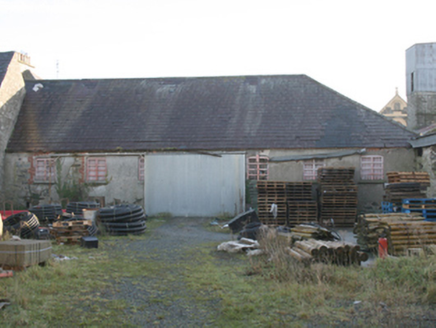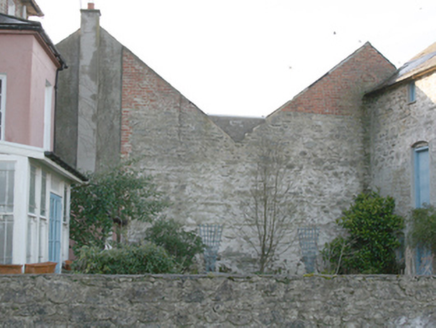Survey Data
Reg No
40823099
Rating
Regional
Categories of Special Interest
Architectural, Technical
Original Use
Store/warehouse
In Use As
Store/warehouse
Date
1860 - 1900
Coordinates
222881, 421338
Date Recorded
01/07/2014
Date Updated
--/--/--
Description
Attached six-bay single-storey warehouse, built c. 1880, having single-storey block to the rear (west) running parallel to main block. Now in use as a builders’ providers. Pitched natural slate roof, hipped to south-end, with cast-iron rainwater goods. Rendered breast to the north gable end. Roughcast rendered walls over smooth rendered plinth course, and with flush smooth rendered block-and-start quoins to the corners of the front elevation. Roughcast rendered walls to the rear elevation, now failing exposing squared and coursed rubble stone construction with red brick block-and-start surrounds to the openings. Red brick construction to the north elevation at gable apex level. Segmental-headed window openings with smooth rendered block-and-start surrounds, thin slate sills, wrought-iron security bars, and with battened timber shutters. Square-headed carriage-arch opening having metal sliding double-doors. Rock-faced granite wheel guards to either side of carriage-arch having drafted margins, and with pyramidal heads. Road-fronted to the north-east of the centre of Ramelton close to the quayside. Yard to the rear having rubble stone boundary wall to the west (adjacent to quayside) with rubble stone soldier coursing over, and with modern corrugated-metal gates. Outbuilding, formerly in use as a garage, to the south side of yard having rubble stone walls, mono-pitched corrugated-metal roof, and with altered square-headed openings.
Appraisal
This modest building, probably originally dating to the very end of the nineteenth century, retains much of its original form and character despite some limited later modifications. Its visual appeal and integrity are enhanced by the retention of salient fabric such as the natural slate roof. The render block-and-start surrounds to the openings, and the quoins to the corners, add interest and demonstrate a conscious desire to give this modest industrial warehouse building and office a strong architectural character and presence in the streetscape. The render to the rear is now failing exposing rubble stone construction with red brick surrounds to the openings, which is typical of many industrial buildings dating to the second half of the nineteenth century. The rock-faced wheel guards to the carriage add some modest additional interest. The front elevation conceals a surprisingly large structure to the rear with a block running parallel to the front section. Although now in a new use, this building forms part of an important group of warehouses and associated structures at Ramelton that constitute a significant element of the built heritage, and the social and industrial history of the area, and help give Ramelton an almost unique character. As with many of the buildings in the Ramelton area, it was formerly associated with the Kelly family, merchants who exported farm produce (notable corn and flour) to Britain (mainly to the Merseyside and Clyde regions) and further a field, and imported salt, coal, and grain to Donegal. This building makes a positive contribution to the streetscape to the north-east of the centre of Ramelton. It was built in conjunction with now derelict two-storey building further to the south (see 40800417) with which it shares similar detailing. The now altered outbuilding to the rear and the fine rubble stone boundary wall to the west aligning the quayside add to the context and setting. This building (or yard to rear) probably occupies the site of a castle and bawn (and possibly built using stone from same), (see RMP DG046-005007-), which was originally built by Sir William Stewart (the original proprietor of Ramelton) by 1619. The yard to the rear was used as a set in the 1995 BBC TV series ‘The Hanging Gale’, which was set in Ireland in 1846 at the start of the Great Famine, adding some additional interest.
